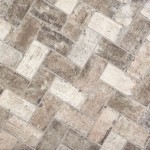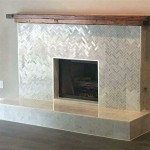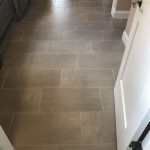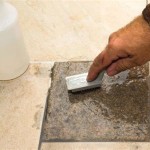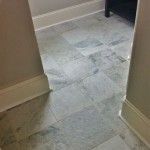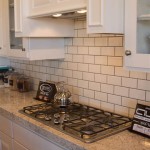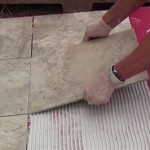Do I Need Cement Board Under Bathroom Tile?
The decision regarding the necessity of cement board under bathroom tile is a critical one, directly impacting the longevity, durability, and overall performance of the tiled surface. Understanding the function of cement board and the conditions it is intended to address is essential for making an informed choice. Incorrect installation or inadequate subsurface preparation can lead to costly repairs down the line, including cracked tiles, water damage, and mold growth.
Cement board, also known as cement backer board, is a rigid panel composed of cement, reinforced with fibers. It is specifically designed to provide a stable, water-resistant substrate for tile installations in areas exposed to moisture, such as bathrooms, showers, and kitchens. Its primary purpose is to create a durable and dimensionally stable surface that can withstand the constant presence of water and humidity without deteriorating or compromising the integrity of the tile installation.
The need for cement board is contingent upon various factors, including the existing substrate, the location of the tile installation, and the expected level of exposure to moisture. In some cases, alternatives to cement board may be considered, but these alternatives must also meet specific requirements for water resistance and structural stability. Ignoring these requirements can lead to significant problems over time.
Understanding Substrate Requirements for Tile Installation
The substrate, which is the surface beneath the tile, plays a crucial role in the success of any tile installation. It must be structurally sound, level, clean, and capable of supporting the weight of the tile and the installation materials. In bathrooms, where moisture is a constant concern, the substrate must also be resistant to water damage. Common substrates include drywall, plywood, and existing concrete or tile surfaces. However, not all of these are suitable for tile installation in wet areas without proper preparation.
Drywall, also known as gypsum board, is commonly used for walls but is not inherently water-resistant. Standard drywall will readily absorb moisture, leading to swelling, crumbling, and ultimately, failure of the tile installation. While moisture-resistant drywall, often referred to as "green board," offers some improved resistance to moisture compared to standard drywall, it is not waterproof and is generally not recommended as a suitable substrate for tile in areas with direct water exposure, such as shower walls or floors. Using green board alone in a shower area without proper waterproofing and potentially cement board underneath increases the risk of water damage and mold growth behind the tile.
Plywood, while structurally sound, is also susceptible to water damage. Prolonged exposure to moisture can cause plywood to warp, rot, and delaminate, compromising the stability of the tile installation. Although exterior-grade plywood offers some improved water resistance compared to interior-grade plywood, it is still not considered a suitable substrate for tile in wet areas without proper waterproofing and the addition of a cement board layer. Without these precautions, the plywood can swell and contract, placing stress on the tile and grout, leading to cracking and eventual failure.
Concrete, on the other hand, is a naturally water-resistant material. However, concrete surfaces can be porous and may still allow moisture to penetrate. Furthermore, concrete surfaces can be uneven or cracked, requiring proper preparation before tile installation. If the concrete substrate is adequately prepared and sealed, it may be suitable for tile installation without cement board in some situations, particularly on floors where the concrete slab provides inherent structural support and water resistance. However, even in these cases, the use of a waterproofing membrane is highly recommended to prevent moisture migration through the concrete.
Existing tile surfaces can also serve as a substrate for new tile installations, provided that the existing tile is securely bonded to the underlying substrate and is in good condition. Loose or damaged tiles must be removed and the surface properly prepared before installing new tile. The existing tile surface must also be thoroughly cleaned and roughened to provide a good bond for the new tile adhesive. In some cases, a self-leveling compound may be necessary to create a smooth and even surface. If the existing tile is installed over a substrate that is not water-resistant, such as drywall or plywood, the underlying substrate must be properly waterproofed before installing new tile. Applying a waterproofing membrane over the existing tile before applying the new tile can provide an extra layer of protection against moisture penetration.
The Benefits of Using Cement Board
Cement board offers several key benefits that make it an ideal substrate for tile installations in wet areas. Its primary advantage is its superior water resistance compared to other common building materials. Cement board does not swell, crumble, or delaminate when exposed to moisture, ensuring the long-term stability and integrity of the tile installation. This is crucial in bathrooms, where constant exposure to water and humidity can quickly degrade other types of substrates.
Cement board also provides a strong and stable surface for tile adhesion. Its rough texture provides an excellent bond for thin-set mortar, ensuring that the tile is securely attached to the substrate. This enhanced bond strength helps to prevent tiles from cracking, loosening, or popping off over time. The rigidity of cement board also helps to distribute the weight of the tile evenly across the substrate, further reducing the risk of stress fractures and other types of damage.
Furthermore, cement board is resistant to mold and mildew growth. This is especially important in bathrooms, where the warm, humid environment can create ideal conditions for mold to thrive. By using cement board, homeowners can reduce the risk of mold contamination and improve the overall air quality in their bathrooms. The inorganic composition of cement board provides no nutrients for mold to feed on, making it an inhospitable environment for mold growth. This contributes to a healthier and more hygienic bathroom environment.
Cement board is also relatively easy to install. It can be cut to size using a utility knife or a circular saw, and it can be fastened to studs or joists using screws or nails. The panels are typically available in standard sizes, making it easy to cover large areas quickly and efficiently. Proper installation techniques, including staggering the joints and using cement board tape and thin-set mortar to seal the seams, are essential for ensuring a watertight installation.
Alternatives to Cement Board and When They Might Suffice
While cement board is generally the preferred substrate for tile installations in wet areas, there are some alternatives that may be considered under specific circumstances. These alternatives typically involve enhancing the water resistance of existing substrates rather than replacing them entirely.
Waterproofing membranes, such as liquid-applied membranes or sheet membranes, can be used to create a waterproof barrier over existing substrates like drywall or plywood. These membranes are designed to prevent water from penetrating the substrate, protecting it from damage. However, it's important to note that simply applying a waterproofing membrane over a substrate that is not structurally sound or resistant to water damage may not be sufficient. The underlying substrate must still be able to support the weight of the tile and resist any potential movement or deformation caused by moisture.
For example, if installing tile over drywall, even with a waterproofing membrane, the drywall must be properly installed and supported according to building codes. The waterproofing membrane will provide a layer of protection against water penetration, but it will not prevent the drywall from sagging or crumbling if it is not properly supported. In such cases, cement board should be considered as a more reliable and durable substrate.
Another alternative is to use a waterproof gypsum board, which is a type of drywall that is specifically designed to be water-resistant. However, even waterproof gypsum board is not completely waterproof, and it is still susceptible to damage if exposed to prolonged or excessive moisture. It is typically recommended for use in areas with moderate moisture exposure, such as bathroom walls that are not directly exposed to shower spray. For shower walls and floors, cement board is still the preferred option.
In some cases, a combination of different materials may be used to create a waterproof and structurally sound substrate. For example, a layer of plywood may be covered with a waterproofing membrane and then topped with a layer of cement board. This approach can provide both structural support and enhanced water resistance. However, it is important to ensure that all materials are compatible and that the installation is performed according to the manufacturer's instructions. Proper installation is key to ensuring the long-term performance of the tiled surface.
Ultimately, the decision of whether or not to use cement board under bathroom tile depends on a variety of factors, including the specific conditions of the installation, the level of moisture exposure, and the desired level of performance and durability. In most cases, cement board is the best option for ensuring a long-lasting and trouble-free tile installation in wet areas. Consulting with a qualified tile contractor or building professional is advisable to determine the most appropriate substrate for a particular project. This ensures the best possible outcome and avoids costly mistakes down the line.

Installing Cement Board In The Bathroom Angie S Roost

How To Install Cement Board On A Floor Diy Family Handyman

Tile Installation Backer Board Around A Bathtub Family Handyman

Tile Backerboard Material Options Fine Homebuilding

Installing Cement Board In The Bathroom Angie S Roost

Installing Cement Board In The Bathroom Angie S Roost
Drywall And Cement Board For The Downstairs Bathroom Blog Homeandawaywithlisa

How To Install Cement Board For Tile Bower Power
Setting The First Wall Tile In Bathroom Blog Homeandawaywithlisa
Drywall And Cement Board For The Downstairs Bathroom Blog Homeandawaywithlisa
Related Posts

